
Common name:Gulf Stream Heavenly Bamboo
Botanical name:Nandina domestica 'Gulf Stream'
Gulf Stream Heavenly Bamboo is a small shrub that is great for accenting because of its unusual red and yellow colored foliage.
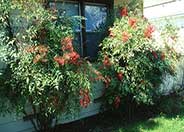
Common name:Nandina, Heavenly Bamboo
Botanical name:Nandina domestica
Nandina domestica is a graceful upright shrub that grows from 3'-6' in height. It gets its name from its bamboo-like growth habit. When thinned from the center it bears a remarkable resemblance to bamboo. It is best used in groups. It can be used in a shaded patio or out in a shrub border with full sun. An interesting feature of Heavenly Bamboo is the bronze color in the new growth when planted in full sun. It also bears clusters of white flowers in the spring.

Common name:Star Jasmine, Maile Haole
Botanical name:Trachelospermum jasminoides
Star Jasmine is an evergreen vine that grows 20' tall or a ground cover that reaches 1'-2' tall and 4'-5' wide. It has white fragrant flowers in the summer and can tolerate sun or partial shade. The star jasmine needs regular watering. Leaves are dark green, oval, thick, about 2" long. This is a great plant on a trellis, in containers or in a parking strip.

Common name:Pygmy Date Palm, Roebelin Palm
Botanical name:Phoenix roebelenii
This tree will grow to about 10' tall and has dark green, spiny petiole foliage. It does well in full sun to heavy shade; it likes moderate to heavy irrigation, but can take periods of dryness.
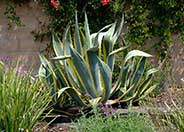
Common name:Variegated Century Plant
Botanical name:Agave americana 'Variegata'
This Agave has a creamy yellow margins around the edge of the leaves. It will grow 6'-10' tall by up to 13' wide. It is native to Mexico. It has a very open growth habit, with leaves that recurve along their length.
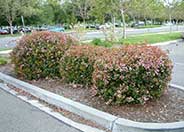
Common name:Indian Hawthorne
Botanical name:Rhaphiolepis indica
This small shrub will grow 2' tall and 4' wide. It has small, dark green leaves that get a red tint in the winter and deep pink flowers that bloom fall through spring.
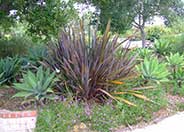
Common name:New Zealand Flax, Purple
Botanical name:Phormium tenax 'Atropurpureum'
Phormium tenax 'Atropurpureum' is an evergreen perennial. Big, dramatic plant composed of many swordlike, stiffly vertical leaves can reach 5' tall. Leaves are purple red. Flowers stems reach high above leaves, bearing clusters of 1"-2" blossoms in dark red.
Maintenance Tips
Phormium tenax 'Atropurpureum' is one of the most popular hybrids of Flax. This variety matures at 4-6' tall and wide. The leaves are strap-shaped, and deep purple, tall flower stalks appear in the summer up to 10' tall. To keep the maintenance as low as possible, plant in a location that is full sun, and well-drained and give it the space it needs to reach maturity. These plants are often the victim of poor pruning habits, with gardeners cutting the leaves off in the middle or shearing them because they are too large for the space they have been given. If this is the case, they should be transplanted to a location where they can reach their full size, or other plants around them should be moved out of their way. Old leaves rarely fall off of the plant, so removing them as they age will help keep the plant looking and performing its best.
Common name:Peppermint Tree
Botanical name:Agonis flexuosa
Peppermint Tree (Agonis flexuosa) is an excellent specimen tree for small- and medium-sized gardens. This Australian native tree reaches 35' tall and 15’-30’ wide, is very low-water-use, and is low maintenance. These trees can be found in nurseries in both single-trunk and multi-trunk forms. The natural growth habit is weeping and irregular, so it does require some selective pruning and shaping when it is young to achieve the desired look. Thinning out the heavy, weeping branches will take some of the weight out of them, and they usually lift. The tree may require this type of pruning a few times a year for the first two or three years. Once it has reached a height requiring a ladder to prune, it should be shaped by a licensed arborist. Since this tree has very low water use, it is susceptible to root rot during the hotter months if it is overwatered. It does very well in California-friendly gardens that typically prefer most of their irrigation in the fall, winter, and spring, with very little supplemental water in the summer. This tree should be planted at least five feet away from any hardscape areas, 10 feet from structures such as houses and buildings, and not near any powerlines. Shrubs and perennials should be planted about three feet away from this tree. It should be irrigated for about 45 minutes once a week when using most in-line drip irrigation systems.
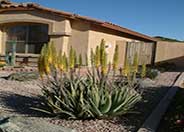
Common name:Aloe Vera or Medicinal Aloe
Botanical name:Aloe vera
The rosette of this plant consists of fleshy gray green leaves, which are narrow, succulent and erect with soft spines on margins. This Aloe is a slow to moderate grower. Flowers are spikes of yellow, 2'-3' tall and bloom late winter to summer. This aloe can form large clumps. It will tolerate full to partial sun, needs some supplemental water in heat and good drainage. It attracts hummingbirds. This aloe is a Mediterranean native. The sap is used for burns and abrasions.
Photographer: GardenSoft
Practice grass-cycling by leaving short grass clippings on lawns after mowing, so that nutrients and organic matter are returned to the soil.
Develop healthy soil for plants that are vigorous and naturally pest-resistant.